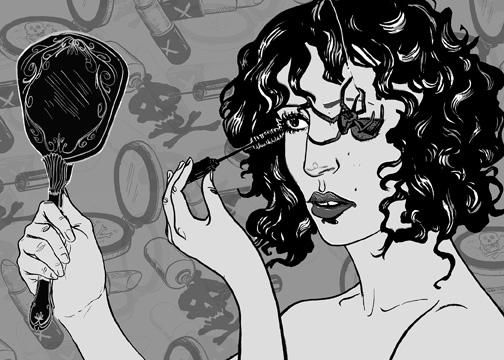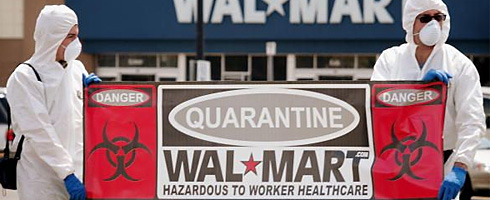
© Taryn Egan
From the pages of every mainstream women's magazine - between the list of 43 things every confident woman knows and the six-week ab-blasting plan - the ads beckon. Conditioners enriched with vitamins vow to make each strand 10 times stronger. Undereye concealers containing white-tea antioxidants claim to combat the cellular damage that deepens those oh-so-unsightly dark circles. Pricey foundations promise to rejuvenate the face at the molecular level with the new Pro-Xylane compound, carefully extracted from Eastern European beech trees. These days, more and more personal care products are promising to harness the power of nature to beautify us from the inside out. Makeup doesn't merely make us look good, we're told - now it's good for us, too.
Jeremy Brecher, Tim Costello and Brendan Smith
TruthoutMon, 15 Dec 2008 22:47 UTC

© Scott Olson / Getty ImagesActivists protest Wal-Mart's health care coverage. More and more workers are struggling with inadequate employer-based coverage.
As Americans respond to President-elect Obama's call for town hall meetings on reform of the American health care system, an understanding of how that system came to be the way it is can be crucial for figuring out how to fix it. The American health care system is unique because, for most of us, it is tied to our jobs rather than to our government. For many Americans, the system seems natural, but few know that it originated not as a well-thought-out plan to provide for Americans' health, but as a way to circumvent a quirk in wartime wage regulations that had nothing to do with health.
Maryn McKenna
SelfThu, 16 Oct 2008 20:19 UTC
For Emily White, it felt like the worst flu ever. It was in the spring of 2006, and White was pushing through her final term at college. Sure, she was stressed and run-down. But she just didn't understand how her symptoms could be so intense.
White, then 22, was headed to law school, and would lie awake at night, her mind running nonstop over paying for school, keeping her friendships going, maintaining her 3.8 grade point average and living up to the law-firm job she'd snagged for the summer. She was exhausted, yet sleep was impossible. This didn't feel like run-of-the-mill anxiety, though. It was something physical. All over her body - throat, armpits, groin - her lymph nodes swelled up, and she ran a fever. Her face grew lumps, painful and hot, like cystic acne that refused to get better. She dragged herself to class but had trouble putting words together.
And then, within a couple of weeks, the lumps on her face sprouted...something. At first, she thought they were hairs and tried to yank them with tweezers, but they felt "rooted in cement," she says. Her skin had always been good; but for the first time in her life, she spackled on concealer to try to hide the bristly rash.
Ran Reznick
HaaretzTue, 16 Dec 2008 18:49 UTC
The Health Ministry has launched an investigation into the sudden deaths in the past month of four babies and the severe illness of two others.
The cases, some of which were reported to the ministry in recent weeks by hospitals, including Schneider Children's Medical Center and the Sourasky Medical Center in Tel Aviv, involved serious neurological and cardiac damage to the babies, but in most of the cases, no reason has been determined as yet for the illnesses or the deaths. The initial ministry probe has turned up no connection among all six cases, although the ministry is still seeking one.
Hattie Kauffman
CBS NewsFri, 04 Mar 2005 16:55 UTC
Could mold inside your home or apartment be deadly?
One California woman believes toxic mold killed her 2-year-old daughter. She's joined dozens of other tenants in a lawsuit. The Early Show National Correspondent Hattie Kauffman reports.
As Jennifer Lair walks her daughter, Skyla, and a friend, to school, she fears Skyla will once again expect her little sister, Neveah, to be home at the end of the day.
Lair says, "Skyla, she, at first, she was angry. Now she just questions: When is she coming home? Or is she coming home?"
Two-year-old Neveah Lair died suddenly last year.
Since the Clinton administration made biotechnology "a strategic priority for U.S. government backing" (1), giant transnational agri-business concerns have aggressively taken over the global food chain by flooding it with Genetically Modified Organisms (GMO) without regard for the consequences to the earth or its inhabitants. This takeover not only has the potential for global economic devastation, but threatens the earth's population with far-reaching health concerns as well. One health concern that seems to coincide with the GMO revolution is Morgellons disease. What if the advent of Morgellons disease has something to do with the ingestion of GMO foods?
Morgellons Disease - What is it?Very little can be found regarding this disease. Originally, sufferers were told that their problem was imaginary. This was of little comfort to the people who were suffering.
Morgellons Disease sufferers report strange, fiber-like material sticking out of sores or wounds that erupt on the skin. This is accompanied by painful, intense itching, that has been described as "an ever present sensation as if something is crawling under the skin." (2)
Nightmare on Elm Street's Dinner Table. Thank you, Monsanto!
© UnknownFibers removed from lesions on the skin of Morgellon’s Disease sufferers.
Just in case you thought it was fine to eat Genetically Modified foods (better identified as "FrankenFoods"), along comes a study which makes it clear that you are eating this make believe non-food at your own peril and, worse yet, you are feeding it to your kids at their peril as well. It is important to note that Codex Alimentarius, which sets standards for the international trade of food, permits genetically modified foods and makes no effort to limit, control or eliminate them. In fact, the US has been trying for years to prevent the labeling of GM foods and seed in international trade to emulate its domestic policy which prohibits any label indication that foods contain GM ingredients, as 75-80% of all foods sold in the US do.
Now it appears that the increasingly prevalent nightmare of a disease called "Morgellon's Disease" may be a result of GM crops and food.
Morgellon's Disease was first described when a woman's 3 year old son developed rashes and intensely itchy sores which produced weird multicolor fibers emerging from his skin. She put up a website about the condition in 2001 and named it "Morgellons Disease" after a 17th century report of a similar affliction.
Nicole Maestri
ReutersTue, 16 Dec 2008 15:33 UTC
New York - A paralegal, recently laid off, wanted to get back at the "establishment" that he felt was to blame for his lost job. So when he craved an expensive new tie, he went out and stole one.
The story, relayed by psychiatrist Timothy Fong at the UCLA Neuropsychiatric Institute and Hospital, is an example of the rash behaviors exhibited by more Americans as a recession undermines a lifestyle built on spending.
In the coming months, mental health experts expect a rise in theft, depression, drug use, anxiety and even violence as consumers confront a harsh new reality and must live within diminished means.
"People start seeing their economic situation change, and it stimulates a sort of survival panic," said Gaetano Vaccaro, deputy clinical director of Moonview Sanctuary, which treats patients for emotional and behavioral disorders.
"When we are in a survival panic, we are prone to really extreme behaviors."

During meditation we process the deep tracks of our unconscious mind that will lead into better self-understanding
For thousands of years, Buddhist meditators have claimed that the simple act of sitting down and following their breath while letting go of intrusive thoughts can free one from the entanglements of neurotic suffering.
Now, scientists are using cutting-edge scanning technology to watch the meditating mind at work. They are finding that regular meditation has a measurable effect on a variety of brain structures related to attention - an example of what is known as neuroplasticity, where the brain physically changes in response to an intentional exercise.
Comment: One of the most effective breathing techniques to aid in these results can be found
here.
Eating too much and putting on weight may be more to do with one's state of mind rather than a metabolic imbalance, according to a study that reveals six genes linked with obesity.
Five of the genes are active in the brain which is why scientists believe that the discovery could lead to new obesity treatments aimed at changing people's psychology towards food rather than their physical desire to eat.
The study was based on a genetic analysis of 90,000 people, whose DNA was analysed for the smallest mutations, and compared against their body mass index, the scientific assessment based on their height and weight. Scientists found six genetic variants that appear to cause a small but significant increase in weight. If someone carried all six variants they would typically be between 1.5kg and 2kg (3.3lb and 3.4lb) heavier than the average person.

Comment: One of the most effective breathing techniques to aid in these results can be found here.